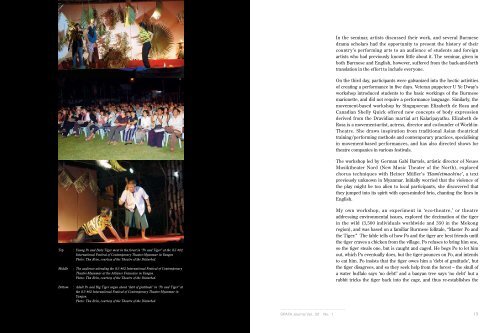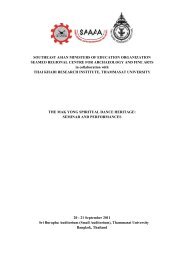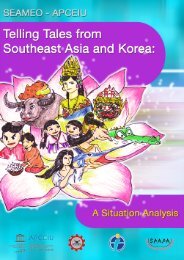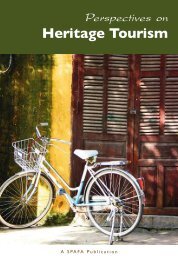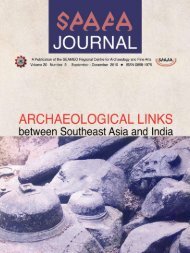Traditional Theatre in Southeast Asia - Southeast Asian Center for ...
Traditional Theatre in Southeast Asia - Southeast Asian Center for ...
Traditional Theatre in Southeast Asia - Southeast Asian Center for ...
Create successful ePaper yourself
Turn your PDF publications into a flip-book with our unique Google optimized e-Paper software.
12<br />
Top : Young Po and Baby Tiger meet <strong>in</strong> the <strong>for</strong>est <strong>in</strong> “Po and Tiger” at the iUi #02<br />
International Festival of Contemporary <strong>Theatre</strong>-Myanmar <strong>in</strong> Yangon<br />
Photo: Thu Re<strong>in</strong>, courtesy of the <strong>Theatre</strong> of the Disturbed.<br />
Middle : The audience attend<strong>in</strong>g the iUi #02 International Festival of Contemporary<br />
<strong>Theatre</strong>-Myanmar at the Alliance Francaise <strong>in</strong> Yangon.<br />
Photo: Thu Re<strong>in</strong>, courtesy of the <strong>Theatre</strong> of the Disturbed.<br />
Bottom : Adult Po and Big Tiger argue about “debt of gratitude” <strong>in</strong> “Po and Tiger” at<br />
the iUi #02 International Festival of Contemporary <strong>Theatre</strong>-Myanmar <strong>in</strong><br />
Yangon.<br />
Photo: Thu Re<strong>in</strong>, courtesy of the <strong>Theatre</strong> of the Disturbed.<br />
.....................................................<br />
SPAFA Journal Vol. 20 No. 1<br />
.....................................................<br />
SPAFA Journal Vol. 20 No. 1<br />
In the sem<strong>in</strong>ar, artists discussed their work, and several Burmese<br />
drama scholars had the opportunity to present the history of their<br />
country’s per<strong>for</strong>m<strong>in</strong>g arts to an audience of students and <strong>for</strong>eign<br />
artists who had previously known little about it. The sem<strong>in</strong>ar, given <strong>in</strong><br />
both Burmese and English, however, suffered from the back-and-<strong>for</strong>th<br />
translation <strong>in</strong> the ef<strong>for</strong>t to <strong>in</strong>clude everyone.<br />
On the third day, participants were galvanized <strong>in</strong>to the hectic activities<br />
of creat<strong>in</strong>g a per<strong>for</strong>mance <strong>in</strong> five days. Veteran puppeteer U Ye Dway’s<br />
workshop <strong>in</strong>troduced students to the basic work<strong>in</strong>gs of the Burmese<br />
marionette, and did not require a per<strong>for</strong>mance language. Similarly, the<br />
movement-based workshop by S<strong>in</strong>gaporean Elizabeth de Roza and<br />
Canadian Shelly Quick offered new concepts of body expression<br />
derived from the Dravidian martial art Kalaripayathu. Elizabeth de<br />
Rosa is a movement-artist, actress, director and co-founder of World-<strong>in</strong>-<br />
<strong>Theatre</strong>. She draws <strong>in</strong>spiration from traditional <strong>Asia</strong>n theatrical<br />
tra<strong>in</strong><strong>in</strong>g/per<strong>for</strong>m<strong>in</strong>g methods and contemporary practices, specialis<strong>in</strong>g<br />
<strong>in</strong> movement-based per<strong>for</strong>mances, and has also directed shows <strong>for</strong><br />
theatre companies <strong>in</strong> various festivals.<br />
The workshop led by German Gabi Bartels, artistic director of Neues<br />
Musiktheater Nord (New Music Theater of the North), explored<br />
chorus techniques with He<strong>in</strong>er Müller’s ‘Hamletmach<strong>in</strong>e’, a text<br />
previously unknown <strong>in</strong> Myanmar. Initially worried that the violence of<br />
the play might be too alien to local participants, she discovered that<br />
they jumped <strong>in</strong>to its spirit with open-m<strong>in</strong>ded brio, chant<strong>in</strong>g the l<strong>in</strong>es <strong>in</strong><br />
English.<br />
My own workshop, an experiment <strong>in</strong> ‘eco-theatre,’ or theatre<br />
address<strong>in</strong>g environmental issues, explored the decimation of the tiger<br />
<strong>in</strong> the wild (3,500 <strong>in</strong>dividuals worldwide and 350 <strong>in</strong> the Mekong<br />
region), and was based on a familiar Burmese folktale, “Master Po and<br />
the Tiger.” The fable tells of how Po and the tiger are best friends until<br />
the tiger craves a chicken from the village. Po refuses to br<strong>in</strong>g him one,<br />
so the tiger steals one, but is caught and caged. He begs Po to let him<br />
out, which Po eventually does, but the tiger pounces on Po, and <strong>in</strong>tends<br />
to eat him. Po <strong>in</strong>sists that the tiger owes him a ‘debt of gratitude’, but<br />
the tiger disagrees, and so they seek help from the <strong>for</strong>est – the skull of<br />
a water buffalo says ‘no debt!’ and a banyan tree says ‘no debt’ but a<br />
rabbit tricks the tiger back <strong>in</strong>to the cage, and thus re-establishes the<br />
13


